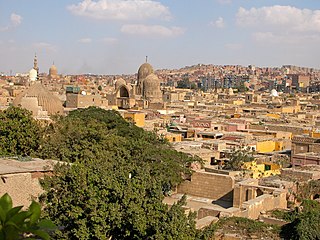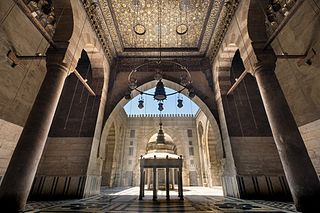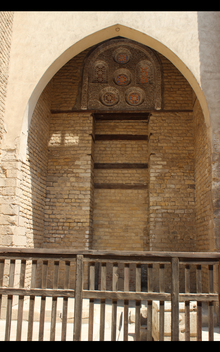
The Fatimid Caliphate or Fatimid Empire was a caliphate extant from the tenth to the twelfth centuries CE under the rule of the Fatimids, an Isma'ili Shia dynasty. Spanning a large area of North Africa and West Asia, it ranged from the western Mediterranean in the west to the Red Sea in the east. The Fatimids trace their ancestry to the Islamic prophet Muhammad's daughter Fatima and her husband Ali, the first Shia imam. The Fatimids were acknowledged as the rightful imams by different Isma'ili communities as well as by denominations in many other Muslim lands and adjacent regions. Originating during the Abbasid Caliphate, the Fatimids initially conquered Ifriqiya. They extended their rule across the Mediterranean coast and ultimately made Egypt the center of the caliphate. At its height, the caliphate included—in addition to Egypt—varying areas of the Maghreb, Sicily, the Levant, and the Hejaz.
Following the Islamic conquest in 641-642, Lower Egypt was ruled at first by governors acting in the name of the Rashidun Caliphs and then the Umayyad Caliphs in Damascus, but in 750 the Umayyads were overthrown. Throughout Islamic rule, Askar was named the capital and housed the ruling administration. The conquest led to two separate provinces all under one ruler: Upper and Lower Egypt. These two very distinct regions were governed by the military and followed the demands handed down by the governor of Egypt and imposed by the heads of their communities.

Islamic Cairo, or Medieval Cairo, officially Historic Cairo, refers mostly to the areas of Cairo, Egypt, that were built from the Muslim conquest in 641 CE until the city's modern expansion in the 19th century during Khedive Ismail's rule, namely: the central parts within the old walled city, the historic cemeteries, the area around the Citadel of Cairo, parts of Bulaq, and Old Cairo which dates back to Roman times and includes major Coptic Christian monuments.
Abū Muḥammad ʿAbd Allāh ibn Yūsuf ibn al-Ḥāfiẓ, better known by his regnal name al-ʿĀḍid li-Dīn Allāh, was the fourteenth and last caliph of the Fatimid dynasty, and the twenty-fourth imam of the Hafizi Isma'ili branch of Shi'a Islam, reigning from 1160 to 1171.

Khan el-Khalili is a famous bazaar and souq in the historic center of Cairo, Egypt. Established as a center of trade in the Mamluk era and named for one of its several historic caravanserais, the bazaar district has since become one of Cairo's main attractions for tourists and Egyptians alike. It is also home to many Egyptian artisans and workshops involved in the production of traditional crafts and souvenirs. The name Khan el-Khalili historically referred to a single building in the area; today it refers to the entire shopping district.

The City of the Dead, or Cairo Necropolis, also referred to as theQarafa, is a series of vast Islamic-era necropolises and cemeteries in Cairo, Egypt. They extend to the north and to the south of the Cairo Citadel, below the Mokattam Hills and outside the historic city walls, covering an area roughly 4 miles (6.4 km) long. They are included in the UNESCO World Heritage Site of "Historic Cairo".

The Beshtak Palace or Qasr Bashtak is a historic palace and museum in Cairo, Egypt, built in the 14th century by the Mamluk amir Sayf al-Din Bashtak al-Nasiri. It is located on Shari'a al-Mu'izz, in the area known as Bayn al-Qasrayn.

Al-Muizz li-Din Allah al-Fatimi Street, or al-Muizz Street for short, is a major north-to-south street in the walled city of historic Cairo, Egypt. It is one of Cairo's oldest streets as it dates back to the foundation of the city by the Fatimid dynasty in the 10th century, under their fourth caliph, Al-Mu'izz li-Din Allah . Historically, it was the most important artery of the city and was often referred to as the Qasaba. It constituted the main axis of the city's economic zones where its souqs (markets) were concentrated. The street's prestige also attracted the construction of many monumental religious and charitable buildings commissioned by Egypt's rulers and elites, making it a dense repository of historic Islamic architecture in Cairo. This is especially evident in the Bayn al-Qasrayn area, which is lined with some of the most important monuments of Islamic Cairo.

The Qalawun complex is a massive pious complex in Cairo, Egypt, built by Sultan al-Mansur Qalawun from 1284 to 1285. It is located at Bayn al-Qasrayn on al-Mu'izz street and like many other pious complexes includes a hospital (bimaristan), a madrasa and mausoleum. Despite controversy surrounding its construction, this building is widely regarded as one of the major monuments of Islamic Cairo and of Mamluk architecture, notable for the size and scope of its contributions to legal scholarship and charitable operations as well as for the richness of its architecture.

Bayn al-Qasrayn is an area located along al-Mu'izz Street in the center of medieval Islamic Cairo, within present day Cairo, Egypt. It corresponds to what was formerly a plaza between two palace complexes constructed in the 10th century by the Fatimids, as part of their palace-city named al-Qahirah. This later became the site of many monumental buildings constructed during the Ayyubid, Mamluk, and Ottoman periods, up to the 19th century. Many of these historical monuments are still standing today.

Al-Azhar Mosque, known in Egypt simply as al-Azhar, is a mosque in Cairo, Egypt in the historic Islamic core of the city. Commissioned as the new capital of the Fatimid Caliphate in 970, it was the first mosque established in a city that eventually earned the nickname "the City of a Thousand Minarets". Its name is usually thought to derive from az-Zahrāʾ, a title given to Fatimah, the daughter of Muhammad.

The Madrasa of al-Nasir Muhammad is a madrasa and mausoleum located in the Bayn al-Qasrayn area of al-Muizz street in Cairo, Egypt. It was built in the name of the Mamluk sultan al-Nasir Muhammad ibn Qalawun, but its construction began between 1294 and 1295 under the reign of Sultan al-Adil Kitbugha, who was sultan in between al-Nasir Muhammad's first and seconds reigns. When al-Nasir Muhammad returned to the throne in 1299 he oversaw its construction until its completion in 1303. It is adjacent to the earlier hospital and funerary complex of Sultan Qalawun and the later Madrasa of Sultan Barquq.

The Fatimid architecture that developed in the Fatimid Caliphate (909–1167 CE) of North Africa combined elements of eastern and western architecture, drawing on Abbasid architecture, Byzantine, Ancient Egyptian, Coptic architecture and North African traditions; it bridged early Islamic styles and the medieval architecture of the Mamluks of Egypt, introducing many innovations.

Mosque-Madrasa of Sultan Barquq or Mosque-Madrasa-Khanqah of Az-Zaher Barquq is a religious complex in Islamic Cairo, the historic medieval district of Cairo, Egypt. It was commissioned by Sultan al-Zahir Barquq as a school for religious education in the four Islamic schools of thought, composed of a mosque, madrasa, mausoleum and khanqah. The complex was constructed in 1384-1386 CE, with the dome added last. It was the first architectural facility built during the rule of the Circassian (Burji) dynasty of Mamluk Sultanate.
Abu'l-Hasan Ali al-Adil ibn al-Sallar or al-Salar, usually known simply as Ibn al-Sal[l]ar, was a Fatimid commander and official, who served as the vizier of Caliph al-Zafir from 1149 to 1154.

The following outline is provided as an overview of and topical guide to Cairo:
The Fatimid conquest of Egypt took place in 969 when the troops of the Fatimid Caliphate under the general Jawhar captured Egypt, then ruled by the autonomous Ikhshidid dynasty in the name of the Abbasid Caliphate.
The vizier was the senior minister of the Fatimid Caliphate for most of the Egyptian period of its existence. Originally it was held by civilian officials who acted as the chief civilian ministers of the caliphs, analogous to the original model established by the Abbasids. When a vizier was not appointed, an "intermediary" was designated instead. The enfeeblement of the caliph's power and the crisis of the Fatimid regime under Caliph al-Mustansir, however, led to the rise of military strongmen, who dominated the post from the 1070s until the caliphate's end. These "viziers of the sword" were also commanders-in-chief of the army who effectively sidelined the caliphs and ruled in their stead, often seizing power from their predecessors. The last vizier, Saladin, abolished the Fatimid Caliphate in 1171.

The Maristan of al-Mu'ayyad or Bimaristan al-Mu'ayyadi is a bimaristan constructed by the Mamluk sultan al-Mu'ayyad Sheikh between 1418 and 1420. It is located on the southern edge of the Darb al-Ahmar district in Cairo, Egypt, near the Citadel of Cairo and the former Bab al-Wazir gate. It did not serve its function as hospital very long and stood ruined for many years. Its facade and main walls have survived, and have been recently restored.

















